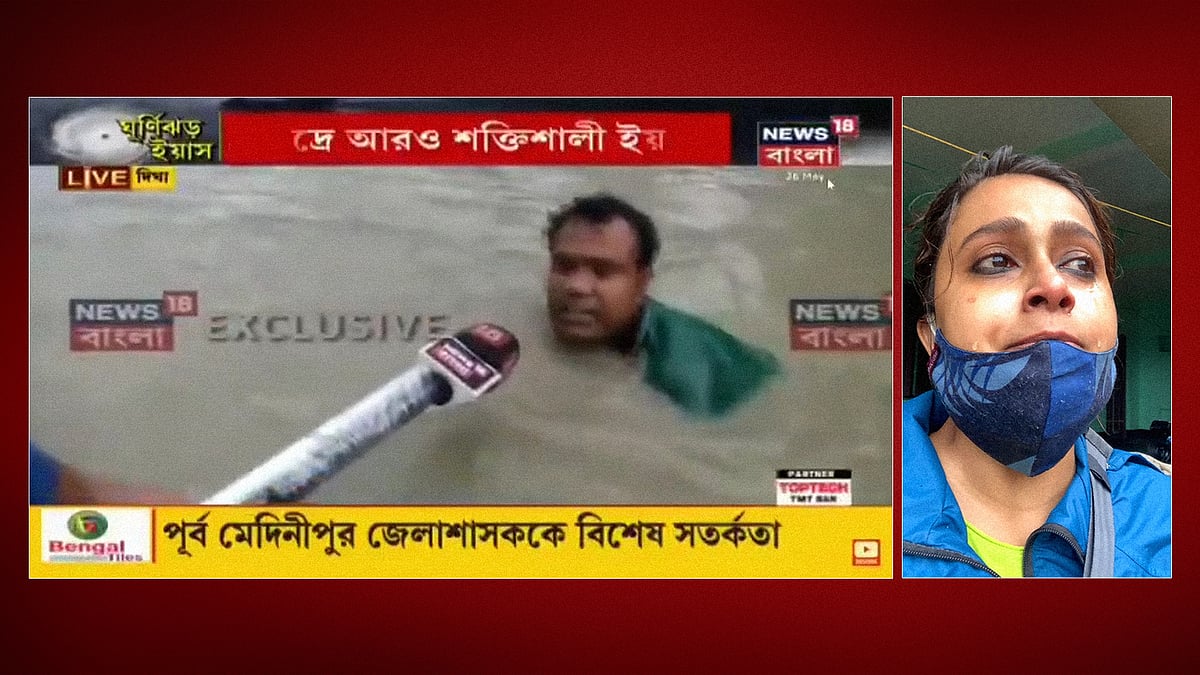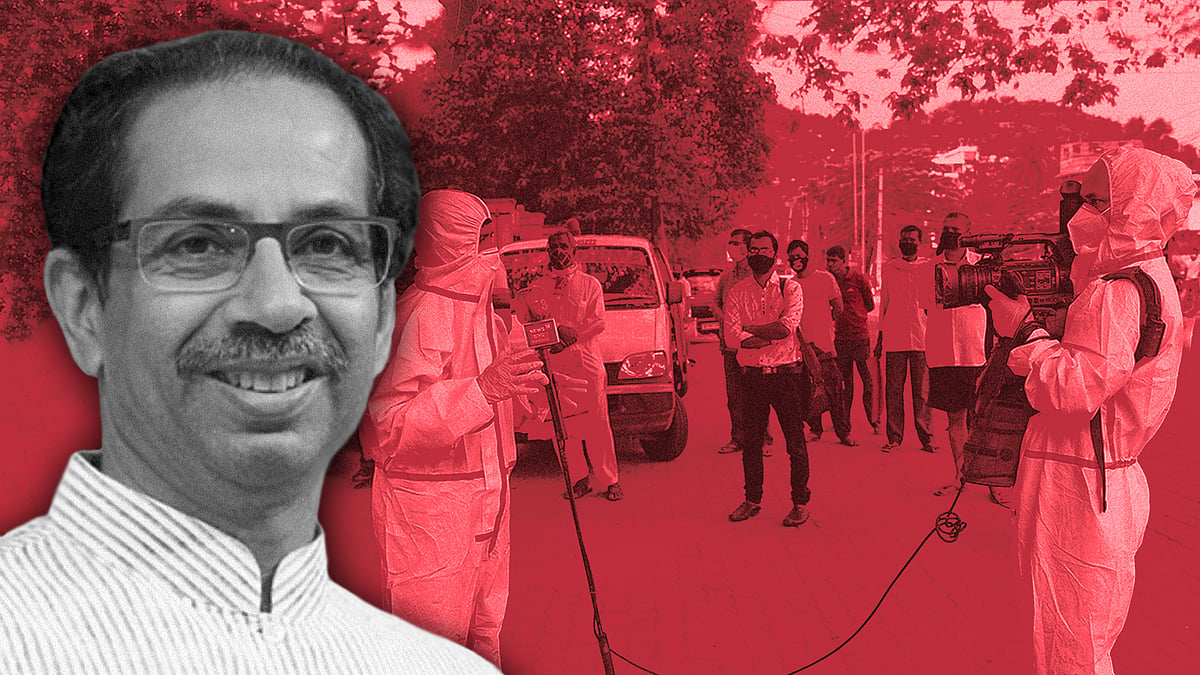No SOPs and a race for TRPs: Why did an Odisha reporter die during a ‘rescue’ mission?
OTV journalist Arindam Das was on board a disaster management boat to rescue an elephant when it capsized.
“I have a short span of life. Don’t worry about me.”
This is what OTV journalist Arindam Das told a friend three years ago, when he was dispatched to the Satkosia tiger reserve in Odisha’s Angul to get pictures of a tigress who had been moved to the reserve from Madhya Pradesh.
Das stood metres away from the tigress, who was named Sundari, to get the photos he wanted. At the time, his friend Jyotiprakash Mahapatra remembers now, he asked Das, “Why are you putting your life in danger?”
Three years later, Mahapatra has only memories of Das, 39, who died on September 24 while reporting on a rescue mission in Cuttack. Das had been on a boat with OTV cameraperson Prabhat Sinha and members of the Odisha Disaster Rapid Action Force. They were on their way to rescue an elephant “stuck” near a bridge.
The boat capsized in the Mahanadi river. Two people died, including Das. Sinha was critically injured.
Video footage of the incident showed Das wearing a life jacket while doing a piece to camera on the boat. As the boat – which was actually an inflatable dinghy – approached the elephant, it was caught in a whirlpool. It then flipped over.
Das left behind his wife, two-year-old son, and his mother.
The incident raised numerous questions: Why was an OTV team sent on a precarious rescue mission? Why did the elephant, which could swim, need “rescuing” in the first place, when it was clearly scared by the crowds of people gathered on the riverbanks? Why did OTV put its reporter in danger? Did it have a standard operating procedure in place?
OTV’s response so far is a tweet from its cofounder and managing director, Jagi Mangat Panda, the wife of BJP national vice president Jay Panda. The channel will also pay Das’s family compensation of Rs 20 lakh.
‘He died live on television’
Mahapatra and Das were friends from the Indian Institute of Mass Communication in Dhenkanal. Das graduated in 2003 while Mahapatra was a year his senior. They were also roommates in the IIMC hostel.
“Arindam was one of the finest reporters,” Mahapatra told Newslaundry. “He started as a crime reporter and, with his ground reports, went on to become an expert in disaster reporting.”
Like thousands of others, Mahapatra was an “eyewitness” to what happened to Das, because the entire incident played out on live television. Das had texted him just hours before, suggesting that they “have lunch together once the shoot wraps up”.
Mahapatra explained that the Mahanadi, one of the biggest rivers in Odisha, had seen numerous floods. He was also baffled by why his friend was in the boat at all.
“Elephants know how to swim. The ODRAF team was trained to swim,” he said. “But those accompanying the team” – meaning Das and Sinha – “were not trained to swim.”
Mahapatra added that “thousands of people” were gathered to watch the elephant, including the cops. “But no one tried to clear the area,” he said. “The crowd swelled, scaring the elephant even more.”
“Why did the ODRAF team decide to take civilians on a boat?” he asked furiously. “Even as the reporter was doing a live, the news desk could have asked him to come back. He died live on television.”
The answer to this question lies in how news channels in Odisha scramble to grab eyeballs.
Priya Ranjan Sahu, a freelance journalist in Odisha with 30 years of experience, explained that there was a “flip side” to the boom in local news channels since the 1990s.
“The problem is that most media houses here don’t report actual things,” he said. “Yet they have to show something 24×7. And so, they try to dramatise everything. In such an ecosystem, it’s the ground soldier, the reporter, who gets hit.”
According to Sahu, stories on issues like mining and displacement don’t get as much airplay compared to stories of trapped elephants. As someone who knew Das personally, he was shocked by multiple aspects of his death.
“An elephant was amid floodwaters. How can a rubber boat rescue it?” he asked. “This defies logic.”
He also pulled up OTV for its role, pointing out that the ODRAF usually takes its own photographer along and could have provided photos later. Or OTV could have used drone cameras to capture footage of the “rescue”. “How equipped was the reporter in this case?” he asked.
Freelance journalist DN Singh, who was the bureau chief of Zee News in Odisha for 20 years, agreed. “There was no need for the ODRAF to get involved in this kind of rescue operation,” he said.
A senior journalist in Bhubaneswar told Newslaundry, on the condition of anonymity, that reporters are under “undue pressure” to “get something extra while reporting on the ground”. Most local news channels in Odisha,OTV included, were reporting on the elephant that day, he said, instead of other issues like Modi meeting Biden.
A friend of Das’s, who also did not want to be named, described it this way: “It’s a recurring feature of a newsroom. If a reporter from one channel is standing in two metres of water while covering a flood, the other channel will ask its reporter to stand in three metres of water.”
He added, “He [Das] did have issues...He told me how he was thinking of quitting journalism. He even remarked that it was better to sell momos on the streets of Bhubaneswar.”
When reporters are at risk
When journalists are sent to cover calamities, often putting themselves at risk, do their newsrooms have SOPs in place?
Both Sahu and Singh, who have reported on natural disasters, said certain dos and don’ts are in place but a lot more needs to be done to ensure a journalist’s safety.
“When one is on hostile ground, one is trained for the same,” Sahu said. “Organisations like Reuters have their own guidelines. Instructions are always issued not to travel during a cyclone.”
Recalling his experience of covering the super cyclone in Odisha in 1999, Singh said, “Advice is always given not to take risks. But when a reporter is sent to cover a breaking story, he might be on the field for 20-25 days. Even with exhaustion taking a toll, there is no SOP as such in place.”
An independent journalist, who previously worked with Reuters and other international publications, told Newslaundry, “At Reuters, I was told not to travel during night. For every story one works on, some kind of risk assessment is done.”
But even the SOPs put in place by Reuters came under scrutiny after their photojournalist Danish Siddiqui was killed in Kandahar. In an investigative piece put out by Reuters in August, it was revealed that the organisation had allowed Siddiqui to embed with Afghan National Forces despite not having a security expert in Kabul or South Asia.
Soumyajit Pattnaik, the chief editor of Kalinga TV, said his channel sends reporters a “coverage policy” for reporting on cyclones and floods. For instance, during Cyclone Yaas in May, the channel created a Whatsapp group where “warning messages from the meteorological department” were shared with reporters.
“If there is a tidal surge warning,” Pattnaik said, “we immediately tell them not to report standing very close to the sea.”
What did OTV do?
Newslaundry contacted the channel’s news editor, Radhamadhab Mishra, for comment. Mishra said, “Since the investigation is going on, I can’t comment.”
Meanwhile, Newslaundry sent Mishra a detailed questionnaire. Here are the questions we asked; this report will be updated if we receive a response.
Did the assignment desk of OTV give permission to Arindam Das before he boarded the boat with the ODRAF?
When was the last time the input desk spoke with Arindam?
What precautions were ensured by the OTV editorial team before sending a team of reporter and cameraman into a river witnessing flooding?
Are there any SOPs in place at OTV for reporters who are frequently sent for disaster reporting?
A staffer at OTV, who did not want to be named, confirmed that the assignment desk had instructed Das to accompany the ODRAF team. The staffer added, “Once a reporter is on the field, he can also communicate to the desk about adverse situations on the ground.”
Brilliant reporter gone too soon
For now, those who knew Das are struggling with their grief.
Mahapatra recalled going on a reporting assignment with Das in January 2006. At the time, Das had worked with Dharitri and Mahapatra with Samay, both newspapers.
“We went to cover an incident of police firing on tribals in Kalinganagar,” he said. “At least 14 persons were killed. When we reached the spot, both of us were beaten up by tribals.”
As they both lay on the road, Mahapatra said, Das hugged him. “He said we may not return alive. I saw tears in his eyes. Somehow, we boarded a truck and managed to send the story by fax.”
Singh had a story to tell too. “When I was covering Cyclone Phailin in 2013, Arindam was with me,” he said. “He requested me not to do a piece to camera owing to the high velocity of wind. We then managed to pull it off and shot the PTC by holding onto cement pillars.”
 Swimming, nearly sinking: Journalists' day out reporting on Cyclone Yaas
Swimming, nearly sinking: Journalists' day out reporting on Cyclone Yaas ‘If this is a war, just give us the armour’: Why journalists in Maharashtra are protesting
‘If this is a war, just give us the armour’: Why journalists in Maharashtra are protesting 